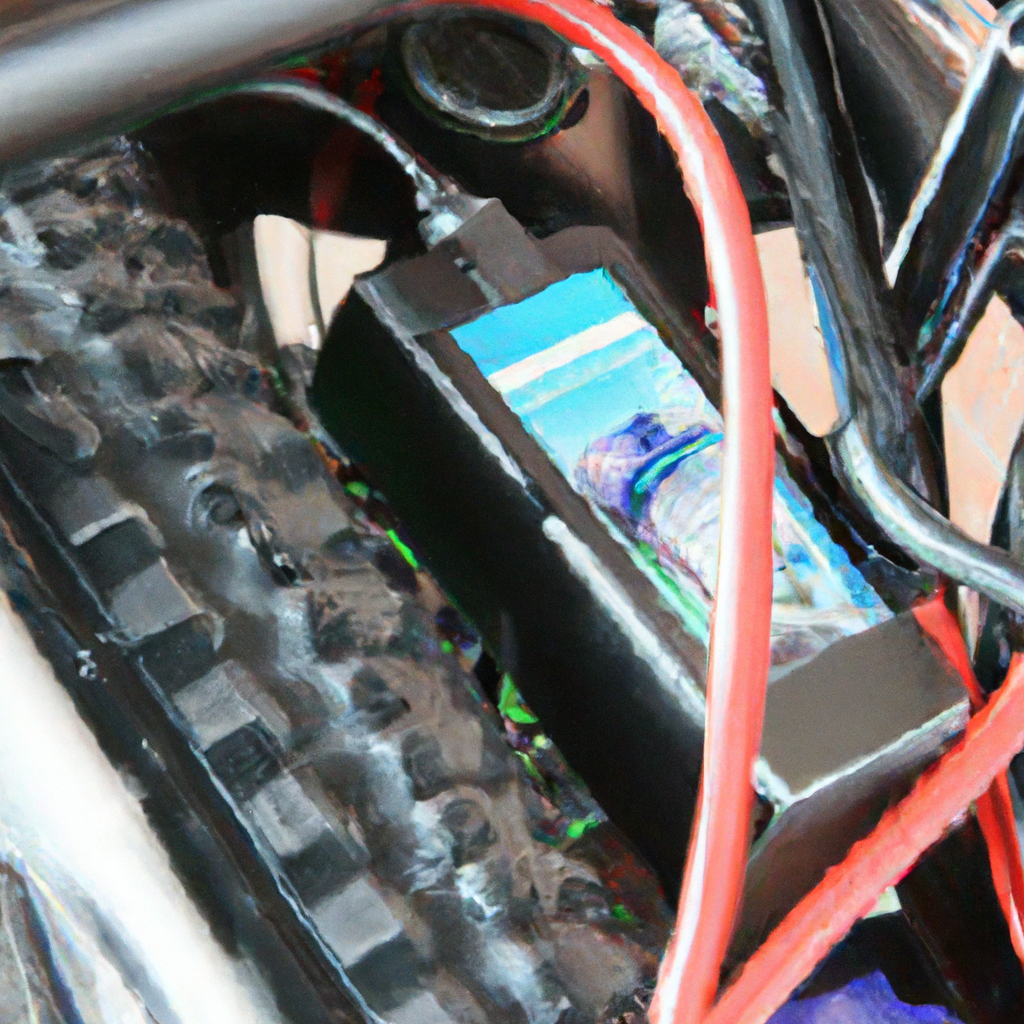If you’re a new electric bike rider, you may be wondering how to get the most out of your battery. After all, the battery is the heart of your electric bike, and without it, you won’t be able to enjoy the convenience and freedom that an e-bike provides. In this article, we’ll explore the key factors that can help you optimize your battery life, ensuring that you can ride longer and farther without worrying about running out of power. From proper charging techniques to storage tips, we’ll cover everything you need to know to keep your electric bike battery in top condition. So, let’s dive in and learn how to maintain your electric bike battery for optimal performance!
Importance of Battery Maintenance
Taking care of your electric bike battery is essential to ensure its longevity and optimal performance. By understanding the role of the battery and following proper maintenance guidelines, you can maximize your battery’s lifespan and get the most out of your e-bike riding experience.
Understanding the role of the battery
The battery is the heart of your electric bike, providing the power that propels you forward. It stores electricity and converts it into usable energy to drive the motor. Without a properly functioning battery, your e-bike would be rendered useless.
Benefits of proper maintenance
Proper battery maintenance offers numerous benefits. First and foremost, it extends the lifespan of your battery. With regular care, you can ensure that your battery lasts for its intended lifespan, saving you money in the long run.
Additionally, maintaining your battery’s health improves its overall performance. A well-maintained battery will provide consistent power output, giving you a smooth and enjoyable riding experience. It also helps maximize the range of your e-bike, allowing you to go further on a single charge.
Furthermore, taking care of your battery reduces the environmental impact of e-bike use. By extending the battery’s life, you contribute to a more sustainable and eco-friendly mode of transportation.
With these benefits in mind, let’s explore some important battery maintenance tips to keep your e-bike running smoothly.
Charging Tips
Properly charging your electric bike battery is crucial for its long-term health and performance. By understanding the charging process, avoiding overcharging, using the right charger, and considering the temperature, you can ensure that your battery remains in optimal condition.
Understanding the charging process
To charge your electric bike battery, you simply connect it to a charger and plug it into a power source. The charger supplies the necessary voltage and current to replenish the energy stored in the battery. It is important to follow the manufacturer’s guidelines regarding charging voltage and current to prevent any damage to the battery.
Charging frequency
How often you should charge your battery depends on your usage and the specific recommendations of the manufacturer. In general, it is best to recharge your battery before it gets too low to ensure optimal performance. Avoid letting the battery sit for extended periods without use or charge, as this can affect its overall health.
Avoid overcharging
Overcharging your electric bike battery can lead to decreased performance and even irreversible damage. Modern e-bike batteries are usually equipped with a built-in management system that prevents overcharging by cutting off the charge when the battery is full. However, it is still important to unplug the charger once the battery is fully charged to avoid unnecessarily stressing the battery.
Use the right charger
Using the correct charger for your specific battery model is essential. Different batteries have different voltage and current requirements, and using an incompatible charger can damage the battery and pose a safety risk. Always refer to the manufacturer’s instructions and use the charger provided or a recommended compatible charger.
Charge at appropriate temperatures
Extreme temperatures can have a significant impact on your battery’s performance and lifespan. Avoid charging your battery in extremely hot or cold environments, as this can cause damage or reduce its overall capacity. Optimal charging temperatures typically range between 50°F (10°C) and 86°F (30°C), so try to charge your battery within this temperature range for optimal results.
By following these charging tips, you can maintain the health and performance of your electric bike battery, ensuring that it serves you well for years to come.

Storage Guidelines
Properly storing your electric bike battery when not in use is essential to maintain its longevity and prevent any deterioration. Whether you need to store your e-bike for an extended period or just overnight, taking the necessary precautions will help preserve the battery’s health.
Preparing for long-term storage
If you plan to store your electric bike for an extended period, it is important to prepare the battery properly. Start by fully charging the battery before storage. This ensures that it has a full charge and prevents it from falling into a deeply discharged state, which can damage the battery cells.
Next, disconnect the battery from the e-bike. This prevents any potential power drain from the bike’s electrical system and reduces the risk of damage during storage. If removable, store the battery in a cool, dry place away from direct sunlight and extreme temperatures.
Proper storage location
Choosing the right location to store your electric bike is crucial. Ideally, it should be a clean, dry area with a stable temperature and humidity level. Avoid storing the bike in areas prone to moisture or temperature extremes, such as garages, sheds, or basements.
If possible, store the battery indoors to protect it from extreme temperatures. Extreme heat or cold can accelerate the degradation of the battery cells and lead to diminished performance. Storing the battery in a temperature-controlled environment will help preserve its overall health.
Maintaining battery during storage
Even during storage, it is important to periodically check and maintain your battery to ensure its longevity. Every few weeks, check the battery’s charge level and, if necessary, top it off to prevent it from falling into a deeply discharged state. This will help prevent capacity loss and prolong the battery’s overall lifespan.
Additionally, ensure that the battery’s connectors are clean and free from any dirt or corrosion. A simple wipe with a clean cloth can help maintain good electrical connections. Inspect the battery for any visible damage or signs of wear, and consult a professional if you notice anything unusual.
By following these storage guidelines and properly caring for your electric bike battery, you can ensure that it remains in excellent condition during periods of non-use and performs optimally when you’re ready to hit the road again.
Temperature Considerations
Temperature plays a crucial role in the performance and lifespan of your electric bike battery. Extreme hot or cold weather conditions can negatively affect the battery’s efficiency and overall health. By understanding the effects of temperature and following some helpful tips, you can ride your e-bike confidently in any weather.
Effects of extreme temperatures on battery performance
Extreme heat can accelerate the degradation of the battery cells and reduce its capacity. It can also lead to increased internal resistance, causing the battery to heat up during operation and potentially triggering safety features that limit power output. In extreme cases, excessive heat can even cause the battery to fail completely.
On the other hand, extreme cold temperatures can temporarily reduce the battery’s overall capacity and power output. Cold weather increases the internal resistance of the battery, making it less efficient. Prolonged exposure to freezing temperatures can also cause irreversible damage to the battery cells.
Tips for riding in hot weather
If you find yourself riding in hot weather conditions, there are a few precautions you can take to protect your battery. First, try to avoid exposing your e-bike to direct sunlight for extended periods, as this can cause the battery to overheat. If possible, park your e-bike in a shaded area or use a bike cover to provide additional sun protection.
It’s also important to hydrate both yourself and your battery. Make sure your battery is adequately cooled before charging, as charging a hot battery can damage its cells. If you notice that your battery is getting hot during a ride, try reducing the power-assist level or taking short breaks to let the battery cool down.
Tips for riding in cold weather
When riding in cold weather, it’s crucial to take steps to protect your battery from extreme temperatures. Start by keeping your battery insulated or storing it in a warm location before riding. This will help retain its charge and reduce the impact of the cold on its performance.
It’s also beneficial to keep the battery as warm as possible during the ride. This can be achieved by using battery covers or insulation wraps specifically designed for e-bike batteries. Additionally, consider riding at a slightly slower pace to minimize heat generation and maximize the battery’s range.
By following these temperature considerations and taking appropriate measures, you can protect your electric bike battery from the damaging effects of extreme temperatures, ensuring its longevity and optimal performance.

Avoiding Battery Drain
Battery drain is a common concern among electric bike riders. When left unattended or not used for a while, e-bike batteries can lose charge gradually, affecting their overall performance and range. By identifying common battery drains, minimizing power-consuming accessories, and properly securing connectors, you can prevent unnecessary battery drainage.
Identifying common battery drains
To avoid unexpected battery drain, it’s important to be aware of common factors that can deplete your battery’s charge. Standby power consumption, such as LED lights or displays left on when not in use, can slowly drain the battery over time. Other factors like continuously running power-consuming accessories or having a faulty electrical connection can also contribute to battery drain.
Minimizing power-consuming accessories
If you have power-consuming accessories like additional lights or GPS systems attached to your e-bike, it’s important to use them judiciously. Running these accessories continuously can significantly reduce your battery’s range. Consider using them only when necessary and switch them off when not in use to conserve battery power.
Properly securing connectors
Loose or improperly secured connectors can cause power leaks and contribute to battery drain. Ensure that all connectors, including the battery-to-bike connection, are securely fastened and free from any dirt or corrosion. Regularly inspect the connectors for any signs of damage or wear and address any issues promptly.
By being mindful of these common battery drains, minimizing power-consuming accessories, and ensuring secure connections, you can prevent unnecessary battery drainage and maximize the lifespan of your e-bike battery.
Battery Cleaning and Care
Proper cleaning and care are essential to keep your e-bike battery in optimal condition. By cleaning the battery, ensuring proper connection, inspecting for damage, and taking precautionary measures during rainy or wet conditions, you can extend the life of your battery and maintain its performance.
Cleaning the battery
Regularly cleaning your battery helps remove dirt, dust, and other debris that can interfere with its performance. Start by turning off your e-bike and disconnecting the battery. Use a soft, dry cloth to wipe down the battery’s exterior, being careful not to use any abrasive materials or harsh chemicals that could damage it.
For any hard-to-remove dirt or grime, lightly dampen a cloth with water or a mild detergent solution and gently wipe the affected areas. Make sure the battery is completely dry before reconnecting it to the e-bike.
Ensuring proper connection
A secure and proper connection between the battery and the e-bike is crucial for optimal performance. Before every ride, check the battery’s connection to ensure it is securely fastened. Loose connections can result in poor power transmission, reduced performance, and additional strain on the battery.
Clean any dirt or corrosion from the battery terminals and connectors using a soft cloth and a solution of baking soda and water. After cleaning, dry the terminals thoroughly and reattach the battery, ensuring a tight connection.
Inspecting for damage
Regularly inspecting your battery for any signs of damage or wear is important for identifying potential problems early on. Look for any visible cracks, dents, or swelling on the battery casing. If you notice any damage, it is recommended to consult a professional for further assessment or battery replacement.
Additionally, pay attention to the battery’s overall performance. If you notice a significant reduction in range or power output, it could be an indication of an underlying issue. Address these concerns promptly to prevent further damage or potential safety hazards.
Proper care during rainy or wet conditions
Electric bike batteries are generally built to withstand light rain or splashes, but immersing them in water or exposing them to heavy rain can cause damage. To protect your battery during wet conditions, consider using a battery cover or a waterproof bag specifically designed for e-bike batteries. This will shield the battery from direct water contact and minimize the risk of moisture damage.
If your battery does get wet, disconnect it from the e-bike and gently dry it with a soft cloth. Avoid using heat sources or excessive force to dry the battery, as this can cause further damage. Allow the battery to air dry completely before reconnecting and using it.
By practicing proper cleaning techniques, ensuring a secure connection, regularly inspecting for damage, and taking precautions during wet conditions, you can maintain the health and performance of your electric bike battery.

Battery Health Monitoring
Monitoring the health of your electric bike battery is crucial for ensuring its longevity and performance. By understanding battery health indicators, using battery management systems, and conducting regular battery health checks, you can proactively address any issues and optimize your battery’s lifespan.
Understanding battery health indicators
Most e-bike batteries are equipped with built-in indicators to display important battery health information. These indicators can provide valuable insights into the battery’s state of charge, voltage, and overall health. Familiarize yourself with the specific indicators and their meanings as per your battery model.
Common battery health indicators include LED lights or a digital display on the battery itself or the e-bike’s control panel. Green lights or a fully charged indication typically represent a healthy battery, while red lights or a low charge indication may signify a battery that requires charging or replacement.
Using battery management systems
Battery management systems (BMS) are designed to monitor and control various aspects of battery performance. They help prevent overcharging, over-discharging, and overheating, ensuring safe and optimal battery operation. BMS also helps balance the individual cells within the battery pack, maximizing their overall lifespan.
Familiarize yourself with the BMS specific to your electric bike battery and follow any manufacturer guidelines for its operation. Be sure to keep the BMS firmware up to date and consult a professional if you notice any unusual behavior or error codes.
Regular battery health checks
In addition to relying on battery health indicators and BMS, conducting regular battery health checks is essential. This involves assessing the battery’s performance, range, and overall condition. Keep track of the battery’s capacity over time and note any significant changes.
You can also use specialized battery testers or multimeters to measure the battery’s voltage and internal resistance. Consult your e-bike’s manufacturer or a knowledgeable professional for guidance on performing these tests and interpreting the results.
By understanding battery health indicators, using battery management systems, and conducting regular battery health checks, you can proactively address any potential issues and effectively monitor the condition of your electric bike battery.
Optimal Riding Practices
In addition to proper battery maintenance, adopting optimal riding practices can significantly impact your e-bike’s battery life and overall performance. By conserving battery power while riding, maximizing efficiency, and understanding power modes, you can get the most out of your electric bike experience.
Conserving battery power while riding
To conserve battery power while riding, there are several steps you can take. Start by using the appropriate power mode for your needs. Lower power modes provide less assistance but consume less battery, while higher power modes offer more assistance but drain the battery more quickly. Experiment with different power modes to find the right balance between assistance and battery consumption.
Additionally, avoid unnecessary acceleration and braking, as these actions consume more energy. Instead, try to maintain a steady pace and take advantage of the e-bike’s momentum. Using lower power modes while riding on flat terrain or downhill can also help conserve battery power.
Efficiency tips for maximizing range
Maximizing the range of your e-bike is a common goal for many riders. To achieve this, consider the following efficiency tips:
-
Keep your tires properly inflated: Under-inflated tires create more rolling resistance, requiring the motor to work harder and draining the battery faster. Check tire pressure regularly and inflate them to the recommended levels.
-
Reduce wind resistance: Riding at higher speeds or against strong headwinds increases wind resistance, requiring more power. To minimize this, try to ride at a moderate pace and consider using aerodynamic accessories, such as streamlined panniers or fairings.
-
Optimize your route: Choose routes that are more flat or have less challenging terrains to minimize power consumption. Avoid unnecessarily steep inclines whenever possible, as climbing hills uses more battery power.
-
Lighten your load: Carrying excessive weight on your e-bike can put additional strain on the battery. Consider removing any unnecessary accessories or carrying lighter loads to maximize efficiency.
Understanding power modes
Most e-bikes come with different power modes or levels of assistance that can be adjusted according to your riding preferences and needs. Understanding these power modes and their corresponding power outputs is important for optimizing your battery’s performance.
Power modes generally range from eco or low to turbo or high, with varying levels of assistance and battery consumption. Eco or low power modes provide lighter assistance but conserve more battery power, making them ideal for longer rides. Turbo or high power modes, on the other hand, deliver maximum assistance but drain the battery more quickly, making them suitable for shorter bursts of speed or challenging terrains.
By adopting optimal riding practices, including conserving battery power, maximizing efficiency, and understanding power modes, you can get the most out of your e-bike battery and enjoy a satisfying riding experience.

Regular Maintenance Schedule
Regular maintenance is vital to keep your e-bike battery and the entire bike in top condition. By incorporating a maintenance schedule into your routine and performing tasks such as checking battery voltage, inspecting terminals, tightening connections, replacing worn-out parts, and lubricating moving parts, you can ensure that your e-bike remains safe, reliable, and efficient.
Checking battery voltage
Monitoring your battery’s voltage regularly provides valuable insight into its state of charge and overall health. Use a voltmeter or a multimeter to measure the voltage of your battery. Compare the reading with the battery manufacturer’s specifications to ensure it falls within the recommended range.
A significant voltage drop may indicate a depleted or damaged battery that requires recharging or replacement. If you notice any significant deviations from the normal voltage range, consult a professional to assess the battery’s condition.
Inspecting battery terminals
The battery terminals play a critical role in transmitting power between the battery and the e-bike’s electrical system. Regularly inspect the battery terminals for dirt, corrosion, or damage. Clean the terminals using a soft cloth and a solution of baking soda and water to remove any buildup.
Ensure that the terminals are tightly fastened and securely connected to the battery. Loose connections can lead to poor power transmission, reduced performance, and increased risk of electrical issues. If you notice any signs of damage or wear, consult a professional for further assessment or replacement if necessary.
Tightening loose connections
As part of your regular maintenance schedule, check all electrical connections throughout your e-bike and make sure they are secure. Vibrations from riding can sometimes loosen electrical connections, which can lead to poor performance and potential safety hazards.
Inspect connectors, wires, and plugs for any looseness or signs of wear. Tighten any loose connections and secure them accordingly. Be sure not to overtighten, as this can damage the connectors. Any damaged connectors or terminals should be addressed promptly to avoid further issues.
Replacing worn-out parts
Over time, certain parts of your e-bike may wear out and require replacement. Check components such as brake pads, tires, and chains regularly for signs of wear or damage. Worn-out parts can affect the overall performance and safety of your e-bike, and they can also put additional strain on your battery.
If you notice any excessive wear or damage, replace the worn-out parts with new ones that are compatible with your e-bike model. Consult the manufacturer’s guidelines or seek professional assistance to ensure proper installation and compatibility.
Lubricating moving parts
Lubricating your e-bike’s moving parts is essential to reduce friction, improve performance, and extend their lifespan. Regularly inspect parts such as chains, derailleurs, and cables for any signs of dryness or rust. Apply an appropriate lubricant to these parts following the manufacturer’s instructions.
Avoid using excessive amounts of lubricant, as this can attract dirt and debris, causing further damage. Wipe off any excess lubricant and ensure that the moving parts are properly coated for smooth operation.
By incorporating these maintenance tasks into your regular schedule, you can proactively address any issues, ensure the longevity of your e-bike battery, and maintain the overall performance and reliability of your electric bike.
E-Bike Battery Replacement
While proper maintenance can extend the lifespan of your e-bike battery, there may come a time when replacement is necessary. By recognizing the signs that indicate battery replacement, choosing the right replacement battery, and properly disposing of old batteries, you can seamlessly transition to a new battery and continue enjoying your e-bike rides.
Signs that battery replacement is needed
There are several signs that indicate the need for a new battery. First, if you notice a significant reduction in your e-bike’s range or power output, it may indicate that the battery is no longer holding a charge effectively. Reduced battery life can also result in frequent recharging, making your rides less enjoyable.
Additionally, if you experience consistent charging issues or notice physical damage to the battery, such as swelling or leaks, it is crucial to consider replacing the battery. These signs may indicate internal problems or compromised safety features, posing a risk to yourself and the e-bike.
Consult the manufacturer’s guidelines or seek advice from a professional to determine if battery replacement is necessary based on your specific situation.
Choosing the right replacement battery
When selecting a replacement battery, it is important to consider several factors. Start by identifying the appropriate battery size and voltage that matches your e-bike’s specifications. Battery capacities may vary, so choose a battery with a capacity that suits your riding needs and preferences.
Pay close attention to compatibility and ensure that the replacement battery is compatible with your e-bike’s electrical system and connectors. It is recommended to consult the manufacturer’s guidelines or seek professional assistance to ensure a proper fit and optimal performance.
Proper disposal of old batteries
Dispose of your old e-bike battery responsibly to minimize environmental impact and ensure safety. Lithium-ion batteries, commonly used in e-bikes, contain hazardous materials and should not be discarded with regular household waste.
Contact your local recycling or waste management authorities to inquire about proper battery disposal methods in your area. They may provide specific instructions or recycling facilities to safely dispose of your old battery.
By recognizing the signs, choosing the right replacement battery, and properly disposing of old batteries, you can seamlessly transition to a new battery and continue enjoying the convenience and adventure of electric bike rides.
In conclusion, maintaining your electric bike battery is essential for its longevity, performance, and your overall riding experience. By understanding the role of the battery, following proper maintenance guidelines, and adopting optimal riding practices, you can maximize the lifespan of your battery and enjoy the benefits of electric biking for years to come. Regular cleaning, storage, temperature considerations, and monitoring battery health are vital components of maintaining the battery’s optimal condition. Furthermore, by avoiding battery drain, conducting regular maintenance, and knowing when to replace the battery, you can ensure that your electric bike always delivers a smooth and reliable ride. By following these comprehensive battery maintenance tips and incorporating them into your regular routine, you can optimize your battery life and enjoy the benefits of electric biking to the fullest.




